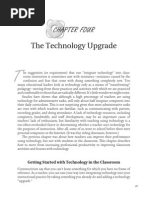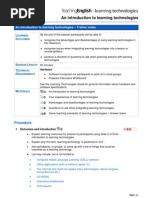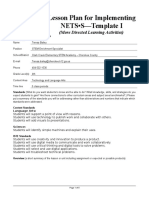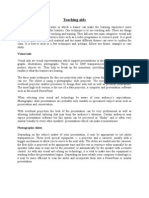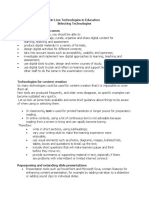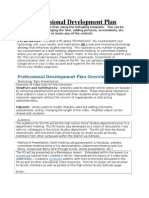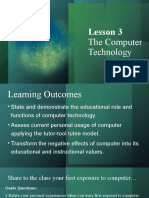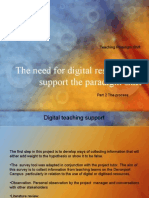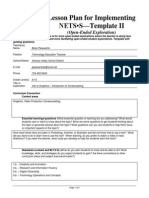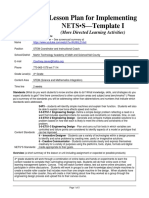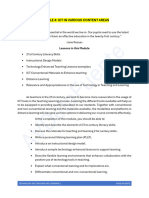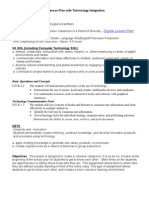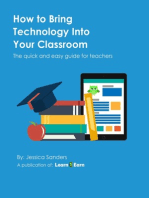Instructional Technology
Instructional Technology
Uploaded by
vaninagarajanCopyright:
Available Formats
Instructional Technology
Instructional Technology
Uploaded by
vaninagarajanOriginal Title
Copyright
Available Formats
Share this document
Did you find this document useful?
Is this content inappropriate?
Copyright:
Available Formats
Instructional Technology
Instructional Technology
Uploaded by
vaninagarajanCopyright:
Available Formats
Instructional Technology
Faculty Center for Learning Development Using Technology to Enhance Teaching and Learning
Before you roll that TV into the classroomremember that technology is just the delivery tool for a specific teaching method or strategy. In order to enhance learning, you need to make sure it is part of a larger design process. Heres one approach to deciding what technology will reap the best benefits: Ask yourself: What are my goals and objectives for this lesson, unit, etc? What teaching methods will best help me reach these goals and objectives? Typical methods are presentation, demonstration, discovery, and problem solving, but there are many more. What activities or delivery tools will match this teaching method best? Typical activities are lecture, lab experiments and case studies. Typical delivery tools include all sorts of instructional media and technology from chalkboards to newer media like computers and the Internet. PowerPoint Example When would I use PowerPoint? If the information you are going to convey is best delivered by presentation (lecture), you might choose a presentation technology to a supplement it. You can choose from many types of presentation technologies including overheads and the blackboard but most instructors today choose PowerPoint. PowerPoint presentations are easy to read, edit, create, present and have the added benefit of communicating to your students that you are able to use current technologies - a vital part of their cultural upbringing and life experiences When would I not use PowerPoint? PowerPoint is very popular for presentations, but it is not appropriate for all teaching methods. If you wanted to illustrate the effects of mixing vinegar and baking soda, a live demonstration would be the best way to convey that learning. If you couldnt do the actual live demonstration in class, you might choose to use video instead, or a simulation on the Internet. Due to developments in the fields of education and psychology, more emphasis has been placed on active methods like collaborative learning and discovery but presentation remains dominant, probably because it is the easiest and most efficient (cost-wise) way to deliver instruction.
3/3/2008 H:\LpWilson\aFCLD_new\Workshops\Nursing\FCLD_IT_Activity07.doc
Faculty Center for Learning Development
Instructional Design Activity
The purpose of this activity is to practice designing lessons using instructional technology. Working in groups, you will begin the process of choosing instructional technology for teaching and learning.
Step One: Identify the Instructional Goal
Your group has been assigned one of the following instructional goals. Conduct step-by-step surgical procedure Identify the parts of a cell Improve Doctors bedside manners
Step Two: Analyze Goal and break it down into steps
For each identified step, ask the following questions: Which of the following category best fits the learning required to accomplish this objective 1 ? o Motor (physical) o Cognitive (dealing with thinking) o Affective (dealing with feelings, emotions) If cognitive, what kind of thinking is required, higher order thinking (e.g., analysis, problem-solving) or lower order thinking (e.g., memorizing terms)?
Taxonomy of Instructional Objectives: http://www.humboldt.edu/~tha1/bloomtax.html Steps Three and Four: Choose Instructional Strategy/Activity for each objective
Choose an instructional method, and then, from the list given, match your instructional method with an instructional activity or technology. The chart below was designed to help you match instructional methods with corresponding instructional technologies. Using the chart, pick an appropriate instructional method for delivering this education and then identify one or two instructional technologies that you feel would help you reach this goal. Instructional Method Presentation Demonstration Role playing Simulation Problem solving Discovery Instructional Technology Activity or Delivery Tool PowerPoint, Blackboard, lecture, slide, posters, bulletinboard, overhead, pencil and paper, interactive flashcards Physical demo (e.g., riding a bike), videotape, slide, models, streaming (internet) video, animation Theatre performance, games, virtual reality experience Computer simulation (flying), models Small group, online discussion, newsgroups, e-mail, videoconference, phone, games Live experiment, field trip, online field trip
Glossary of Instructional Strategies: http://glossary.plasmalink.com/glossary.html
Benjamin Blooms Taxonomy of Educational Objectives
Faculty Center for Learning Development
2005
Step Four: Decide Feasibility and/or Next Steps
Now that you have chosen the activity/technology, you need to determine if there are any constraints to using this technology. Do you have the time to develop the materials required in using this technology? Is there any training or scheduling you need to do? Ask yourself the following questions to find out. � Do you have access to the materials or technology you want to use? � Do your students have access to the materials or technology you want to use? � Do you know how to operate the technology (button pushing)? � Do you have the time to learn this technology? � Do you have the time to create the materials? � Does this material require visual design skills (art)? � Do you know how and where to schedule the technology for use in the classroom? � Who will you call if it doesnt work? � Do you have a contingency plan if the planned activity or the technology doesnt work?
Step Five: Assessment after Instruction Did the student learn? Although we often use a pencil and paper test to assess and measure learning outcomes, you might want to try technology to do this. Here are just a few forms of assessment that use technology: � Online Discussions � Online mini quizzes � Electronic Portfolios � Video projects � Clickers Step Six: Revision and Fine Tuning Did your assessment show that the students are learning the material? If not, you will need to fine tune your process until your assessment shows that learning is taking placebut also be sure that your assessment is measuring the specific learning goals. Instructional Technology Tips � Always remember that choice of technology follows choice of teaching strategy! � Learn to be casual when it doesnt work. Have a backup plan. � Start with simple first steps and build up from there. � Be realistic about what you can do. � Practice using the technology before you get in the classroom � Try to think of your students first. � Learn whom to call to learn and/or to help troubleshoot problems. � Take workshops when you can. � Learn from others. Teach others!! Websites for Nurses
List Servs, search for Nursing Educator discussions - http://www.lsoft.com/catalist.html Professional Development for Nurses - http://www.pblnursing.org/ Nursing Educator Links - http://www.uchsc.edu/CIS/Nurses.html Nursing Educator Links - http://www.enursescribe.com/nurse_educator_page.htm
Faculty Center for Learning Development
2005
Of course, its hard for an instructor to figure out what instructional technologies are really practical for them technologies that are accessible, supportable, easy to learn, and not too time-intensive. These technologies are sometimes called Low Threshold Applications (See: http://www.tltgroup.org/ltas.htm). The following chart was designed to give you a place to start thinking about what technology you might choose given your available time.
Instructional Technology by Learning Curve and Production Time
Low Learning Curve & Production Time (LTAs) Using/Sharing other instructors creations (See: http://www.merlot.org) Basic Blackboard Course Site Basic PowerPoint presentation (computerized overheads or slides) Using e-mail to communicate* Using clipart in Word Showing animations Using e-reserve images or articles through the library Using Online Discussions in Blackboard Inserting pre-made screen captures in Word Posting paper grades using Word** Showing video clips using VCR or DVD Videotaping video lecture Reading and participating in listserv discussions Conducting research using online libraries Advanced Blackboard Course Site Advanced PowerPoint presentation (embedding movies, sound, animations) Participating in online videoconference Creating your own clipart Creating animations in PowerPoint Linking to scanned images or articles Using live chat Capturing own screenshots with keyboard (or similar software) Using Blackboards spreadsheet for grading Videoclips in PowerPoint Streaming video lecture Using non-Blackboard online discussions Conducting research via online field trips Web Site from Scratch using Dreamweaver, Frontpage Flash-powered presentation Live two way video satellite conf. Editing art with Adobe Photoshop Creating Flash animations Scanning slides or articles to use online Using 3-D Chatrooms like SecondLife Creating Screen Capture movies with Camtasia Using Excel Spreadsheets for grading Capturing and burning video clips to DVD Using iMovie, Pinnacle Studio, etc. Podcasting video lecture Blogging (Crooked Timber, etc.) Tagging and sharing research using del.icio.us Medium Learning Curve & Production Time High Learning Curve & Production Time
* These can become time intensive, depending on the number of students involved ** Due to FERPA regulations, this is NOT advisable.
3/3/2008 H:\LpWilson\aFCLD_new\Workshops\Nursing\FCLD_IT_Activity07.doc Faculty Center for Learning Development
Choosing Technology
Here is a partial list of the technologies used in instruction
Software: Word processing, MS PowerPoint, Microsoft (MS) Publisher, MS Excel, Astound, Coral Draw, Lectora, Questionmark/Perception, Adobe Photoshop, Adobe Illustrator, Dreamweaver, FrontPage, Clipart, Authorware, Macromedia Director, Flash, and much, much more. Web 1.0 Internet Technologies: Course Management Software (Blackboard, Web CT), Browsers, Search Engines, Web Sites, Newsgroups, streaming video and audio, web conferences. Web 2.0 Internet Technologies (interactive and/or shared applications): Flicker, Delicious, Blogs, Google.docs, podcasts, folksonomies, mash-ups, wickis Overheads LCD Projectors Filmstrips Audiotapes Videotapes Personal Computers (Mac, PC, or anything else) CD ROMS Screen Capture software (e.g., Camtasia) Posters Models Pencil and Paper (or pens) or Easel Typewriters Slides Stereoscope Films Electronic Databases Electronic Portfolios Electronic Course Packs Bulletinboard Whiteboard with dry erase Electronic Whiteboard Posters Dioramas Television broadcast Computer video games Computerized models (e.g., Turtle) Palm Pilots Live television from satellite
Faculty Center for Learning Development
2005
You might also like
- Assignment 3 - Skills Related Task CELTADocument7 pagesAssignment 3 - Skills Related Task CELTAAmir Din75% (8)
- Learning Episode 3 Teaching StrategiesDocument19 pagesLearning Episode 3 Teaching StrategiesCid PonienteNo ratings yet
- Hpe Forward Planning DocumentDocument5 pagesHpe Forward Planning Documentapi-279625326No ratings yet
- Handbook For Competitive VolleyballDocument361 pagesHandbook For Competitive Volleyballarchitectintx100% (1)
- Excerpt From The Classroom Teacher's Technology Survival Guide by Doug JohnsonDocument6 pagesExcerpt From The Classroom Teacher's Technology Survival Guide by Doug JohnsonLisa Coronado-MorseNo ratings yet
- Daily Lesson Plan in Mathematics 7Document4 pagesDaily Lesson Plan in Mathematics 7Gianmarie Sumagaysay Hilado100% (4)
- Alicia Sukkar TpaDocument49 pagesAlicia Sukkar Tpaapi-428474226No ratings yet
- Choosing TechnologyDocument7 pagesChoosing TechnologySr BlancoNo ratings yet
- AnalysisofatechinfusedlessonDocument5 pagesAnalysisofatechinfusedlessonapi-332352469No ratings yet
- An Introduction To Learning TechnologiesDocument3 pagesAn Introduction To Learning TechnologiesFrantzeska GeNo ratings yet
- Instructional AidsDocument5 pagesInstructional AidsPraba RajamanickamNo ratings yet
- Ict and Language EducationDocument32 pagesIct and Language EducationRowena BartolazoNo ratings yet
- Teaching With TechnologyDocument3 pagesTeaching With TechnologyEdilbert Bonifacio GayoNo ratings yet
- Alignment TemplateDocument4 pagesAlignment Templateapi-242347241No ratings yet
- Tbailey Lesson PlanDocument5 pagesTbailey Lesson Planapi-290253838No ratings yet
- Guiding Principles For Teaching With TechnologyDocument2 pagesGuiding Principles For Teaching With TechnologyRomina Belen Mendez PerezNo ratings yet
- Successful Technology Integration Is More Than Just Getting The Tools Into The ClassroomDocument10 pagesSuccessful Technology Integration Is More Than Just Getting The Tools Into The ClassroomMark BrownNo ratings yet
- Instructor's ManualDocument57 pagesInstructor's ManualGrace WilliamsNo ratings yet
- WK 7 AssgmkraynekjDocument5 pagesWK 7 Assgmkraynekjapi-350170199No ratings yet
- Training AidsDocument5 pagesTraining Aidsurvashirthr86No ratings yet
- CCBHRM ReviewerDocument8 pagesCCBHRM Reviewermolinatherabbit20No ratings yet
- Learning 2.0 Exploring Your Options and Choosing Solutions That Get Results Elizabeth Griep 2009Document4 pagesLearning 2.0 Exploring Your Options and Choosing Solutions That Get Results Elizabeth Griep 2009nobi26No ratings yet
- Topic 6 Selecting TechnologiesDocument7 pagesTopic 6 Selecting TechnologiesGrace MwendeNo ratings yet
- Professional Development Plan: PD/In-serviceDocument6 pagesProfessional Development Plan: PD/In-serviceapi-276270413No ratings yet
- Module 1 Educational TechnologyDocument37 pagesModule 1 Educational TechnologyChesja CastilloNo ratings yet
- LTLE 370 - Instructional Technology: James Madison UniversityDocument8 pagesLTLE 370 - Instructional Technology: James Madison UniversityTonia DousayNo ratings yet
- TTL 2 - How To Integrate TechnologyDocument10 pagesTTL 2 - How To Integrate TechnologyPatrick Ian OmisolNo ratings yet
- Learning Technologies For The Classroom - All SessionsDocument194 pagesLearning Technologies For The Classroom - All Sessionsმარიკა კირვალიძეNo ratings yet
- Technology As Teaching ToolDocument4 pagesTechnology As Teaching ToolJohn Kyle Capispisan TansiongcoNo ratings yet
- PP PP P PPPPPPPPP PP PPP P P PPDocument12 pagesPP PP P PPPPPPPPP PP PPP P P PPBirendra Kumar RajputNo ratings yet
- Technology ReflectionDocument4 pagesTechnology Reflectionapi-445359215No ratings yet
- Benefits of Applying Technology To EducationDocument9 pagesBenefits of Applying Technology To EducationiveethchicasNo ratings yet
- Course 7 - Technology EnrichedDocument35 pagesCourse 7 - Technology EnrichedTRANTHUNo ratings yet
- Technology Integrated Classroom Lesson: TeacherDocument4 pagesTechnology Integrated Classroom Lesson: TeachercollinscmeNo ratings yet
- Applying Technology in EducationDocument10 pagesApplying Technology in EducationiveethchicasNo ratings yet
- Professional Development Plan: PD/In ServiceDocument5 pagesProfessional Development Plan: PD/In Serviceapi-257524543No ratings yet
- AlessiDocument3 pagesAlessiMeister PrabaNo ratings yet
- Guide To Teaching Online FinanceDocument13 pagesGuide To Teaching Online FinancetbmichaelNo ratings yet
- Abailey Lesson PlanDocument4 pagesAbailey Lesson Planapi-263543502No ratings yet
- Lesson 3 - Computer TechnologyDocument21 pagesLesson 3 - Computer TechnologyRemar HernandezllNo ratings yet
- WebSec5 Teachingaids FinalDocument12 pagesWebSec5 Teachingaids FinalKalpana KrishnanNo ratings yet
- Thing 1 Basic DocumentDocument5 pagesThing 1 Basic Documentapi-354411812No ratings yet
- ExcelSHE TNA 2025Document4 pagesExcelSHE TNA 2025Muhammad FarouqNo ratings yet
- The Need For Digital Resources To Support The Paradigm ShiftDocument21 pagesThe Need For Digital Resources To Support The Paradigm ShiftthegreatratNo ratings yet
- Lesson Plan For Implementing NETS - S-Template II: (Open-Ended Exploration)Document3 pagesLesson Plan For Implementing NETS - S-Template II: (Open-Ended Exploration)pes1212No ratings yet
- Thesis Technology in ClassroomDocument8 pagesThesis Technology in ClassroomPaperWritersCollegeUK100% (2)
- Module 01 ActivitiesDocument23 pagesModule 01 ActivitiesScarlettSamanthaAragonNo ratings yet
- 21things4teacherslessonplantemplate FinalDocument3 pages21things4teacherslessonplantemplate Finalapi-253794046No ratings yet
- Lesson Plan For Implementing NETS - S-Template I: (More Directed Learning Activities)Document5 pagesLesson Plan For Implementing NETS - S-Template I: (More Directed Learning Activities)api-338504614No ratings yet
- Module 3 Lesson PlanDocument3 pagesModule 3 Lesson Planapi-724072282No ratings yet
- Guide To Teaching Online For ITDocument16 pagesGuide To Teaching Online For ITRyan OlaybalNo ratings yet
- MODULE 4-TTL1_AVDF_Document15 pagesMODULE 4-TTL1_AVDF_forlifeteaNo ratings yet
- Smart Teacher: A Modern Information Technology of E-Learning SystemDocument21 pagesSmart Teacher: A Modern Information Technology of E-Learning SystemHU ReadersNo ratings yet
- IT MaterialsDocument23 pagesIT Materialsfroilan copilingNo ratings yet
- Summer Funk - Basic Productivity Tools Lesson IdeaDocument4 pagesSummer Funk - Basic Productivity Tools Lesson Ideasummer.funkNo ratings yet
- Creating A CohesiveDocument11 pagesCreating A CohesiveGloria BrogdonNo ratings yet
- BPTs Basic Productivity Tools LESSON IDEA TemplateDocument3 pagesBPTs Basic Productivity Tools LESSON IDEA Templatesummer.funkNo ratings yet
- 30 ReportDocument2 pages30 Reportmacay.najirahNo ratings yet
- How to Bring Technology Into Your Classroom: The quick and easy guide for teachersFrom EverandHow to Bring Technology Into Your Classroom: The quick and easy guide for teachersRating: 3 out of 5 stars3/5 (1)
- Multimedia Lesson-JarrettDocument3 pagesMultimedia Lesson-Jarrettapi-724018672No ratings yet
- 1) Double Click On The Tata Classedge IconDocument16 pages1) Double Click On The Tata Classedge IconSukidharaniNo ratings yet
- Cdelcourt Final Project PortfolioDocument16 pagesCdelcourt Final Project Portfolioapi-267084993No ratings yet
- Choosing The Proper Authoring ToolDocument4 pagesChoosing The Proper Authoring ToolJohn MelendezNo ratings yet
- Chapter 3Document2 pagesChapter 3Leslie JoyNo ratings yet
- Making Math More Fun Math Games Ideas PDFDocument53 pagesMaking Math More Fun Math Games Ideas PDFNachammai Shanmugam100% (2)
- Uni Assist EnglischDocument8 pagesUni Assist Englischhp_blacklight7402No ratings yet
- Why Is It Important For Teachers To Study Child Development?Document8 pagesWhy Is It Important For Teachers To Study Child Development?NeWo YanTotNo ratings yet
- FCE Spotlight Paper 3 and Answer Key PDFDocument16 pagesFCE Spotlight Paper 3 and Answer Key PDFsharkondietNo ratings yet
- Definitions of CurriculumDocument1 pageDefinitions of CurriculumKemoy Francis100% (1)
- Behaviour Management ResourcesDocument7 pagesBehaviour Management ResourcesAhmed MunawarNo ratings yet
- The BoarderDocument2 pagesThe BoarderAnonymous iX6KV9LZzoNo ratings yet
- Young vs. Dallas ISD and Zachary Hall, Petition To CourtDocument13 pagesYoung vs. Dallas ISD and Zachary Hall, Petition To CourtRichard YoungNo ratings yet
- Engleza Propozitii Exemple Traduse Romana EnglezaDocument6 pagesEngleza Propozitii Exemple Traduse Romana EnglezaDiana TreastinNo ratings yet
- Flip BookDocument11 pagesFlip Bookapi-307403301No ratings yet
- DLL Template WeeklyDocument2 pagesDLL Template WeeklyLORLITO MALABORBORNo ratings yet
- Republic of The Philippines BCIS ImplementationDocument3 pagesRepublic of The Philippines BCIS ImplementationBasal JonathanNo ratings yet
- Conversation 1Document8 pagesConversation 1Mariany GilNo ratings yet
- QuoridorDocument13 pagesQuoridorScience HouseNo ratings yet
- Memorandum-6724 (Teacher Load Etc)Document4 pagesMemorandum-6724 (Teacher Load Etc)Paula JanNo ratings yet
- English 12 Character Types PDFDocument4 pagesEnglish 12 Character Types PDFapi-308662690No ratings yet
- Volunteer Handbook 2015Document17 pagesVolunteer Handbook 2015api-285009559No ratings yet
- Research Proposal FormatDocument6 pagesResearch Proposal FormatMuhammad RaashidNo ratings yet
- 5CQDP Nguyen Thi Ngoc Tho Verb Phrase in English and VietnameseDocument25 pages5CQDP Nguyen Thi Ngoc Tho Verb Phrase in English and VietnameselimlinliNo ratings yet
- A Wise Decision ENGDocument28 pagesA Wise Decision ENGShelvin ChandNo ratings yet
- Critical Analysis of Education System ofDocument22 pagesCritical Analysis of Education System ofMado AliNo ratings yet
- Topic/Big Idea: Class/Grade: Essential Questions: Lesson PlanDocument3 pagesTopic/Big Idea: Class/Grade: Essential Questions: Lesson Planapi-299373704No ratings yet
- ResumeDocument2 pagesResumeapi-330392338No ratings yet
- Questions 1-3: Name: - Year: 3Document6 pagesQuestions 1-3: Name: - Year: 3Vasandra DeviNo ratings yet
- 691 Adhd PaperDocument25 pages691 Adhd PaperTammie ZentgrafNo ratings yet




